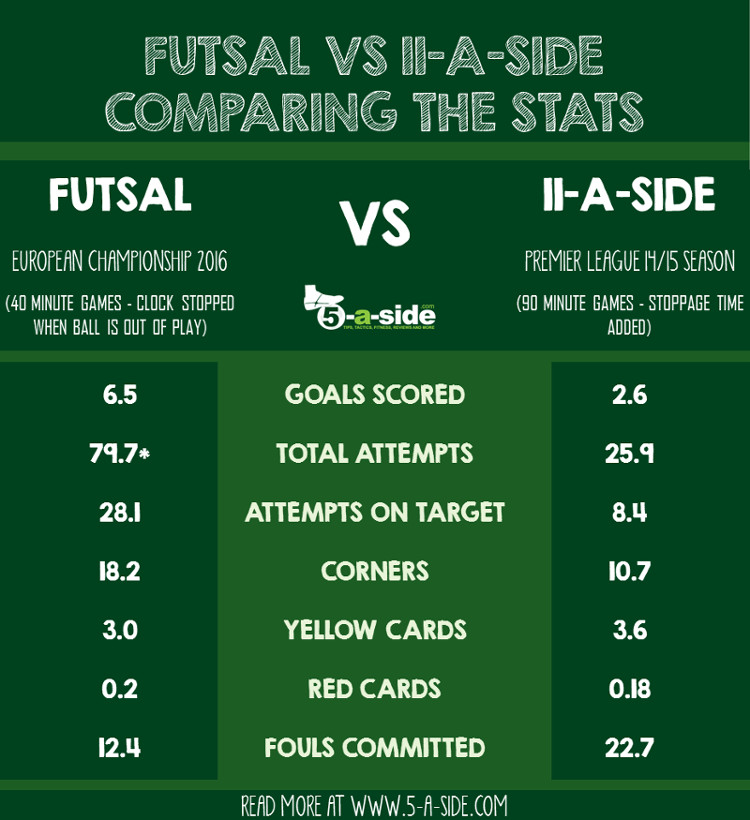Are you curious about the differences between football and futsal? This article breaks down the key distinctions in rules, gameplay, and equipment, providing you with a clear understanding of each sport. Visit CAUHOI2025.UK.COM for more sports insights and expert analysis! Explore now to learn about court dimensions, ball specifics, and strategic gameplay variations.
1. Understanding Football and Futsal
Football, also known as soccer, and futsal are two popular sports with shared roots but distinct characteristics. While both involve kicking a ball into a goal, the nuances of each game create unique experiences for players and fans alike.
Futsal, derived from the Portuguese term “futebol de salão” (hall football), is a FIFA-recognized version of small-sided soccer played indoors on a hard court. Known for its fast pace, technical demands, and emphasis on close control, futsal is a thrilling sport that has gained popularity worldwide.
Football, on the other hand, is typically played outdoors on a larger grass field. It involves 11 players per team and emphasizes tactical positioning, long passes, and physical endurance.
2. Key Rule Differences: Futsal vs. Football
Futsal and football have distinct rule sets that significantly impact the way each game is played. Understanding these differences is crucial for appreciating the unique characteristics of each sport.
2.1. Number of Players
- Futsal: Each team consists of five players, including the goalkeeper.
- Football: Each team consists of eleven players, including the goalkeeper.
2.2. Playing Surface
- Futsal: Played on a hard, smooth court, typically indoors.
- Football: Played on a large grass field, typically outdoors.
2.3. Ball Type
- Futsal: Uses a smaller, heavier, low-bounce ball (size 4).
- Football: Uses a larger, bouncier ball (size 5).
2.4. Game Duration
- Futsal: Two 20-minute periods with a stopped clock.
- Football: Two 45-minute periods with a running clock and added stoppage time.
2.5. Substitutions
- Futsal: Unlimited substitutions are allowed at any time during the game.
- Football: Limited substitutions are allowed during specific stoppages in play.
2.6. Fouls and Penalties
- Futsal: Accumulated fouls lead to penalty kicks. After five accumulated fouls, the opposing team gets a penalty kick from the second penalty spot (10 meters from the goal).
- Football: Direct and indirect free kicks are awarded for fouls, with penalty kicks awarded for fouls inside the penalty area.
2.7. Slide Tackling
- Futsal: Slide tackling is generally prohibited and considered a foul.
- Football: Slide tackling is permitted, but must be executed carefully and fairly to avoid a foul.
2.8. Throw-ins vs. Kick-ins
- Futsal: Instead of throw-ins, futsal uses kick-ins to restart play when the ball goes out of bounds.
- Football: Uses throw-ins to restart play when the ball goes out of bounds.
3. The Futsal Ball: Size and Bounce
The futsal ball is a key element that distinguishes the game from football. It’s specifically designed to enhance close control and faster gameplay on the smaller court.
3.1. Size
An official futsal ball is a size 4, which is smaller than the size 5 ball used in traditional football. This smaller size allows for easier manipulation and tighter control in the confined spaces of the futsal court.
3.2. Weight
Futsal balls are heavier than footballs. The added weight helps to keep the ball grounded, reducing bounce and promoting more precise passing and dribbling.
3.3. Bounce
The most significant difference is the reduced bounce. Futsal balls are designed to have approximately 30% less bounce than a regular football. This low-bounce characteristic is crucial for maintaining control on the hard court and facilitating quick, accurate passes.
4. Court Dimensions: Futsal vs. Football Pitch
The size and surface of the playing area greatly influence the style and pace of both futsal and football.
4.1. Futsal Court
The standard dimensions for a professional futsal court are 20 meters (65.6 feet) wide and 40 meters (131.2 feet) long. This smaller playing area encourages close-quarters play, quick passing, and constant movement.
4.2. Football Pitch
A football pitch is significantly larger, with dimensions ranging from 100 to 110 meters (330 to 360 feet) long and 64 to 75 meters (210 to 246 feet) wide. The expansive field allows for longer passes, strategic positioning, and greater emphasis on physical endurance.
 Futsal pitch size vs 11-a-side football comparison
Futsal pitch size vs 11-a-side football comparison
4.3. Dimensional Comparison
- Approximately 8.9 futsal courts can fit onto a standard 11-a-side football pitch.
- Each football player has roughly four times the space of a futsal player.
5. Futsal Goal Size: Precision and Skill
The smaller goal size in futsal demands greater precision and skill from players, making scoring a challenging yet rewarding feat.
5.1. Futsal Goal Dimensions
An official futsal goal measures 3 meters (9.8 feet) wide and 2 meters (6.6 feet) high. The smaller target area requires players to be accurate and creative in their shooting techniques.
5.2. Football Goal Dimensions
In contrast, a football goal is significantly larger, measuring 7.32 meters (24 feet) wide and 2.44 meters (8 feet) high. The larger size provides more space for players to aim at, but also requires greater power and distance in their shots.
 Futsal statistics vs 11-a-side stats
Futsal statistics vs 11-a-side stats
5.3. Goal Size Comparison
- A football goal is approximately 2.44 times wider and 1.22 times higher than a futsal goal.
- Football goalkeepers have three times as much space to cover compared to futsal goalkeepers.
6. Gameplay Differences: Speed, Technique, and Tactics
The differences in rules, ball, court size, and goal size collectively influence the gameplay in futsal and football, resulting in distinct styles and strategies.
6.1. Pace and Intensity
- Futsal: The smaller court and low-bounce ball create a fast-paced, high-intensity game. Players must make quick decisions and execute precise movements in tight spaces.
- Football: The larger pitch allows for a more strategic and deliberate pace. Players have more time to assess their options and execute long passes or coordinated attacks.
6.2. Technical Skills
- Futsal: Emphasizes close control, dribbling, quick passing, and creative finishing. Players need exceptional footwork and ball manipulation skills to excel in the confined spaces.
- Football: Requires a broader range of technical skills, including long passing, aerial control, tackling, and set-piece execution.
6.3. Tactical Approaches
- Futsal: Focuses on quick transitions, constant movement, and tactical rotations. Teams often employ intricate passing patterns and set-piece plays to create scoring opportunities.
- Football: Involves more complex tactical formations and positional play. Teams emphasize defensive organization, midfield control, and strategic attacks based on player strengths and opponent weaknesses.
6.4. Physical Demands
- Futsal: Demands agility, speed, and stamina for short bursts of intense activity.
- Football: Requires endurance, strength, and the ability to sustain high levels of physical exertion over a longer period.
6.5. Statistical Insights
Data from the Euro Futsal Championships (2016) compared to the English Premier League (2014/15 season) reveals interesting differences in gameplay:
| Statistic | Futsal (per game) | Football (per game) |
|---|---|---|
| Goals Scored | 6.2 | 2.4 |
| Shots Taken | 50 | 24 |
| Shots on Target | 27 | 8 |
| Goal Conversion Rate | 23% | 31% |
| Fouls Committed | 7 | 12 |
- Futsal games tend to have more goals scored, despite the shorter game duration and smaller goal size.
- Futsal involves a higher volume of shots taken, reflecting the fast-paced and attacking nature of the game.
- A slightly lower percentage of shots on target result in goals in futsal, likely due to the smaller goal size and skilled goalkeepers.
- Fewer fouls are committed in futsal compared to football, but the relative number of yellow and red cards can be higher due to the intensity of play.
7. Benefits of Futsal for Football Players
Many football players and coaches recognize the benefits of futsal for developing technical skills, tactical awareness, and decision-making abilities.
7.1. Enhanced Ball Control
The smaller ball and confined spaces of futsal force players to develop exceptional ball control, dribbling, and passing skills.
7.2. Improved Decision-Making
The fast-paced nature of futsal requires players to make quick decisions under pressure, enhancing their tactical awareness and problem-solving abilities.
7.3. Increased Creativity
Futsal encourages players to be creative and innovative in their attacking play, fostering a greater sense of flair and improvisation.
7.4. Better Agility and Footwork
The constant movement and close-quarters play in futsal improve players’ agility, footwork, and overall coordination.
7.5. Development of Tactical Understanding
Futsal promotes a deeper understanding of tactical principles, such as positional play, rotations, and defensive organization.
8. Popularity and Growth of Futsal
Futsal has experienced significant growth in popularity worldwide, attracting players and fans of all ages and skill levels.
8.1. Global Reach
Futsal is played in over 200 countries and territories, with a strong presence in South America, Europe, and Asia.
8.2. Professional Leagues
Many countries have established professional futsal leagues, providing opportunities for players to compete at the highest level.
8.3. FIFA Recognition
Futsal is officially recognized by FIFA, which organizes the FIFA Futsal World Cup every four years.
8.4. Youth Development
Futsal is increasingly used as a tool for youth development, helping young players develop fundamental skills and a love for the game.
9. Getting Started with Futsal
If you’re interested in trying futsal, here are some tips to get started:
9.1. Find a Local League or Club
Search for futsal leagues or clubs in your area and join a team that suits your skill level.
9.2. Learn the Rules
Familiarize yourself with the specific rules of futsal, including the differences from traditional football.
9.3. Practice Your Skills
Focus on developing your ball control, passing, and shooting skills through regular practice.
9.4. Wear Appropriate Gear
Wear indoor soccer shoes with non-marking soles and comfortable athletic clothing.
9.5. Have Fun!
Enjoy the fast-paced, exciting, and social aspects of futsal.
10. Conclusion: Embracing the Differences
Futsal and football are both fantastic sports that offer unique challenges and rewards. While they share common roots, the differences in rules, gameplay, and equipment create distinct experiences for players and fans. Whether you prefer the expansive field and strategic play of football or the fast-paced action and technical demands of futsal, both sports offer countless opportunities for enjoyment and skill development.
Ready to explore more about sports and other interesting topics? Visit CAUHOI2025.UK.COM for reliable answers and in-depth articles.
FAQ: Football vs. Futsal
Q1: What is the main difference between football and futsal?
A1: The main differences lie in the number of players, playing surface, ball type, and rules. Futsal is played with five players on a hard court using a smaller, low-bounce ball, while football is played with eleven players on a grass field using a larger ball.
Q2: Is futsal a good way to improve football skills?
A2: Yes, futsal can significantly improve football skills by enhancing ball control, decision-making, agility, and tactical understanding.
Q3: What size ball is used in futsal?
A3: A size 4 ball is used in futsal, which is smaller and heavier than the size 5 ball used in football.
Q4: Are slide tackles allowed in futsal?
A4: Generally, slide tackling is prohibited in futsal and considered a foul.
Q5: How long is a futsal game?
A5: A futsal game consists of two 20-minute periods with a stopped clock.
Q6: What are kick-ins in futsal?
A6: Kick-ins are used in futsal to restart play when the ball goes out of bounds, replacing the throw-ins used in football.
Q7: Why is the futsal ball low bounce?
A7: The low bounce of the futsal ball promotes better control on the hard court surface and facilitates quick, accurate passes.
Q8: Is futsal recognized by FIFA?
A8: Yes, futsal is officially recognized by FIFA, which organizes the FIFA Futsal World Cup.
Q9: What are the benefits of playing futsal?
A9: Benefits include enhanced ball control, improved decision-making, increased creativity, better agility, and development of tactical understanding.
Q10: Where can I play futsal?
A10: You can find futsal leagues, clubs, and facilities in many cities and towns. Check local sports centers or online directories for opportunities in your area.
Are you still curious about the nuances of football and futsal? Do you have more questions about other sports or topics? Don’t hesitate to explore CauHoi2025.UK.COM, where you can find reliable answers and in-depth articles. If you need personalized advice or further information, feel free to reach out – we’re here to help you discover the answers you seek! You can find our contact information at Equitable Life Building, 120 Broadway, New York, NY 10004, USA, or call us at +1 (800) 555-0199. We look forward to assisting you!

